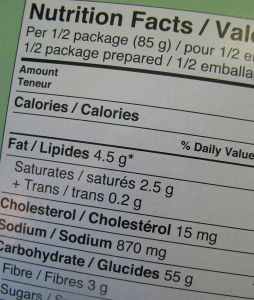“But Mommy, they made me do it!”
 When we hear an idea that disagrees with something we’ve come to believe, our first instinct is to dismiss it and the science supporting it. To let ourselves critically question and think about something that goes against everything we’ve come to feel comfortable believing, is hard and unnerving.
When we hear an idea that disagrees with something we’ve come to believe, our first instinct is to dismiss it and the science supporting it. To let ourselves critically question and think about something that goes against everything we’ve come to feel comfortable believing, is hard and unnerving. The most careful, evidence-based science on dietary and body fat, transfats and cholesterol can be especially hard to embrace. The misinformation has been repeated so often, it has become the most believable. Recognizing the most supportable evidence is made even harder when trusted health authorities let us down.
The food fear of the day is transfats. It has become impossible to discuss it calmly and intelligently anymore because so many can’t get past the “transfats are evil, toxic and deadly” belief. It’s not surprising this misconception has become so widespread, we hear it everywhere.
David Katz, a professor of public health at the Yale University School of Medicine in New Haven, CT, was in the news equating transfats to “mercury and lead, slow poisons that consumers would be shocked to find in their food” and telling consumers “it’s a poison...This is really bad stuff. It’s got to go.” Transfats have been equated to lead paint by Thomas R. Frieden, New York City’s health commissioner. He was quoted in the New York Times saying: “Like lead paint, artificial transfat in food is invisible and dangerous.” And the panic has spreads on the internet with one worried poster saying of a Harvard study: “It found that increasing transfatty acid intake by 2% of total calories doubled the risk of MI! That’s equivalent to a 9-11 every year, just from one teaspoonful a day of trans fats per person!” It would be funny if it wasn’t so sad that people have really become that afraid. As a recent post discussed, the evidence for transfats endangering our health and leading to heart disease, cancer or other health problems is weak. How many remember thirty years ago when we were being led to believe that transfats and all-vegetable margarines were better for us, and animal fats and tropical oils were the bad fats? No wonder consumers are confused — they’re stuck in the middle of a ping-pong ball game that isn’t about their health at all. But a look at the science presented back then to dispel concerns about transfats can offer some reassuring help for us today. Elaine Blume, now Senior Science Writer at the National Cancer Institute of the National Institutes of Health, wrote an article, “The truth about trans: hydrogenated oils aren’t guilty as charged - trans fats,” and its science was surprisingly solid and remains so today. No evidence has ever shown transfats to be a public health concern in the amounts we eat them. Even rats fed extraordinarily high concentrations for 46 generations lived normally and just as long as other rats. Interestingly, her article had been published and distributed by the Center for Science in the Public Interest (CSPI), the same group now leading the scares that transfats are bad for us. What may be leading consumers to feel that fears about transfats were confirmed was the FDA’s ruling that transfats be added to food labels. But it is important to look behind the spin and read their July 9, 2003 ruling closely and understand what it really said and what was behind it. They were careful to word it to make it clear that transfats were like saturated fats in changing cholesterol levels and they downplayed any actual proven health problems. They specifically noted that eliminating transfats from our diet was not necessary and that their ruling wasn’t banning their use or setting recommended dietary intakes. There wasn’t any credible evidence for that. But they did something very unusual for an FDA ruling that normally would have been based solely on the soundness of the scientific evidence. Their 260-page ruling [an abbreviated version for consumers is here] explained that it was done “in part to a citizen petition from CSPI on February 14, 1994” and the subsequent 1,720 letters it had received. The FDA had been targeted by a well-organized media campaign and legal intimidation led by CSPI for a decade. It finally gave in. © 2007 Sandy Szwarc




<< Home